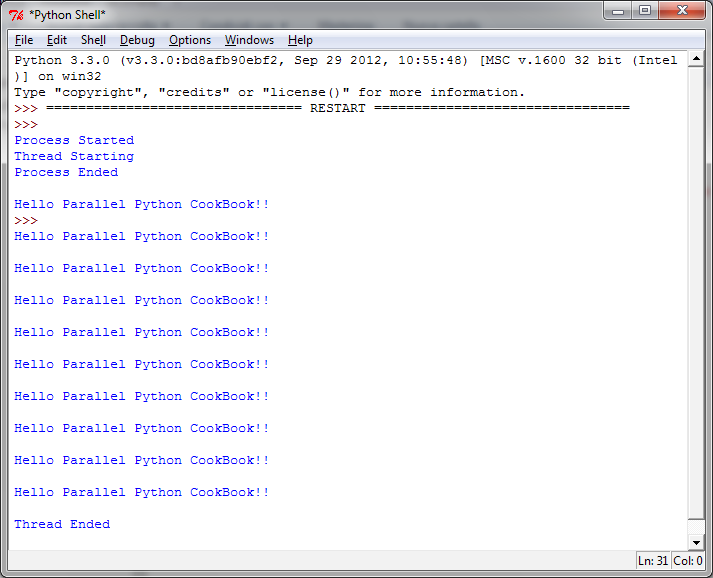Python并行编程
- 本书说明
- 1 认识并行计算和Python
- 1.1 介绍
- 1.2 并行计算的内存架构
- 1.3 内存管理
- 1.4 并行编程模型
- 1.5 如何设计一个并行程序
- 1.6 如何评估并行程序的性能
- 1.7 介绍Python
- 1.8 并行世界的Python
- 1.9 介绍线程和进程
- 1.10 开始在Python中使用进程
- 1.11 开始在Python中使用线程
- 2 基于线程的并行
- 2.1 介绍
- 2.2 使用Python的线程模块
- 2.3 如何定义一个线程
- 2.4 如何确定当前的线程
- 2.5 如何实现一个线程
- 2.6 使用Lock进行线程同步
- 2.7 使用RLock进行线程同步
- 2.8 使用信号量进行线程同步
- 2.9 使用条件进行线程同步
- 2.10 使用事件进行线程同步
- 2.11 使用with语法
- 2.12 使用 queue 进行线程通信
- 2.13 评估多线程应用的性能
- 3 基于进程的并行
- 3.1 介绍
- 3.2 如何产生一个进程
- 3.3 如何为一个进程命名
- 3.4 如何在后台运行一个进程
- 3.5 如何杀掉一个进程
- 3.6 如何在子类中使用进程
- 3.7 如何在进程之间交换对象
- 3.8 进程如何同步
- 3.9 如何在进程之间管理状态
- 3.10 如何使用进程池
- 3.11 使用Python的mpi4py模块
- 3.12 点对点通讯
- 3.13 避免死锁问题
- 3.14 集体通讯:使用broadcast通讯
- 3.15 集体通讯:使用scatter通讯
- 3.16 集体通讯:使用gather通讯
- 3.17 使用Alltoall通讯
- 3.18 简化操作
- 3.19 如何优化通讯
- 4 异步编程
- 4.1 介绍
- 4.2 使用Python的 concurrent.futures 模块
- 4.3 使用Asyncio管理事件循环
- 4.4 使用Asyncio管理协程
- 4.5 使用Asyncio控制任务
- 4.6 使用Asyncio和Futures
- 5 分布式Python编程
- 5.1 介绍
- 5.2 使用Celery实现分布式任务
- 5.3 如何使用Celery创建任务
- 5.4 使用SCOOP进行科学计算
- 5.5 通过 SCOOP 使用 map 函数
- 5.6 使用Pyro4进行远程方法调用
- 5.7 使用 Pyro4 链接对象
- 5.8 使用Pyro4部署客户端-服务器应用
- 5.9 PyCSP和通信顺序进程
- 5.10 使用Disco进行MapReduce
- 5.11 使用RPyC远程调用
- 6 Python GPU编程
开始在Python中使用线程
如前面章节提到的那样,基于线程的并行是编写并行程序的标准方法。然而,Python解释器并不完全是线程安全的。为了支持多线程的Python程序,CPython使用了一个叫做全局解释器锁(Global Interpreter Lock, GIL)的技术。这意味着同一时间只有一个线程可以执行Python代码;执行某一个线程一小段时间之后,Python会自动切换到下一个线程。GIL并没有完全解决线程安全的问题,如果多个线程试图使用共享数据,还是可能导致未确定的行为。
在本节中,我们将展示如何在Python程序中创建一个线程。
如何做
我们需要 helloPythonWithThreads.py 来执行第一个例子: :
# To use threads you need import Thread using the following code:
from threading import Thread
# Also we use the sleep function to make the thread "sleep"
from time import sleep
# To create a thread in Python you'll want to make your class work as a thread.
# For this, you should subclass your class from the Thread class
class CookBook(Thread):
def __init__(self):
Thread.__init__(self)
self.message = "Hello Parallel Python CookBook!!\n"
# this method prints only the message
def print_message(self):
print(self.message)
# The run method prints ten times the message
def run(self):
print("Thread Starting\n")
x = 0
while (x < 10):
self.print_message()
sleep(2)
x += 1
print("Thread Ended\n")
# start the main process
print("Process Started")
# create an instance of the HelloWorld class
hello_Python = CookBook()
# print the message...starting the thread
hello_Python.start()
# end the main process
print("Process Ended")运行上面的代码,需要用Python IDE打开 helloPythonWithThreads.py
然后按下 F5.
在Python shell中你将看到以下输出:

讨论
主程序执行结束的时候,线程依然会每个两秒钟就打印一次信息。此例子证实了线程是在父进程下执行的一个子任务。
需要注意的一点是,永远不要留下任何线程在后台默默运行。否则在大型程序中这将给你带来无限痛苦。